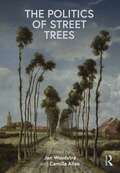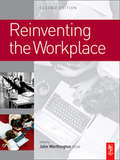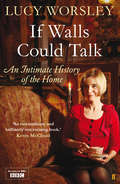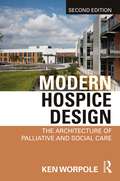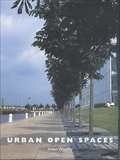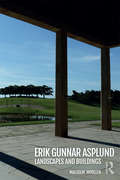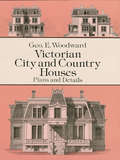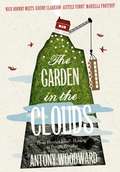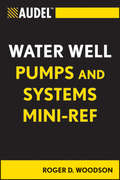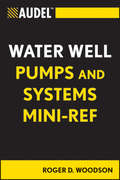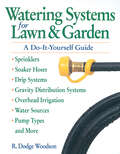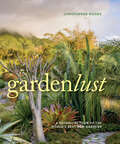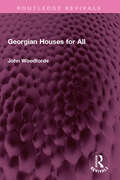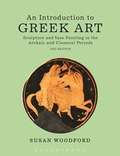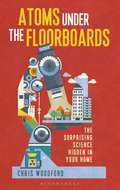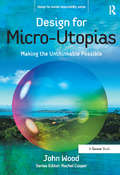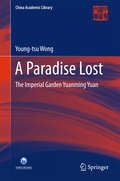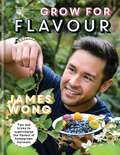- Table View
- List View
The Politics of Street Trees
by Jan WoudstraThis book focuses on the politics of street trees and the institutions, actors and processes that govern their planning, planting and maintenance. This is an innovative approach which is particularly important in the context of mounting environmental and societal challenges and reveals a huge amount about the nature of modern life, social change and political conflict. The work first provides different historical perspectives on street trees and politics, celebrating diversity in different cultures. A second section discusses street tree values, policy and management, addressing more contemporary issues of their significance and contribution to our environment, both physically and philosophically. It explores cultural idiosyncrasies and those from the point of view of political economy, particularly challenging the neo-liberal perspectives that continue to dominate political narratives. The final section provides case studies of community engagement, civil action and governance. International case studies bring together contrasting approaches in areas with diverging political directions or intentions, the constraints of laws and the importance of people power. By pursuing an interdisciplinary approach this book produces an information base for academics, practitioners, politicians and activists alike, thus contributing to a fairer political debate that helps to promote more democratic environments that are sustainable, equitable, comfortable and healthier.
Reinventing the Workplace
by John WorthingtonIncorporating a diversity of practices, cultural and organization change, and new building forms, this book provides ideas, inspiration and analysis of the multitude of ways in which an office space can be designed and utilized. Updated to cope with technological advances, as well as including a new series of case studies on recent Australian, North American and Scandinavian experiences, the contributors draw on a wealth and variety of professional experience to present the best and most innovative solutions for today's office - and tomorrow's workplace.
Reinventing the Workplace
by John WorthingtonIncorporating a diversity of practices, cultural and organization change, and new building forms, this book provides ideas, inspiration and analysis of the multitude of ways in which an office space can be designed and utilized. Updated to cope with technological advances, as well as including a new series of case studies on recent Australian, North American and Scandinavian experiences, the contributors draw on a wealth and variety of professional experience to present the best and most innovative solutions for today's office - and tomorrow's workplace.
If Walls Could Talk: An intimate history of the home
by Lucy WorsleyWhy did the flushing toilet take two centuries to catch on? Why did Samuel Pepys never give his mistresses an orgasm? Why did medieval people sleep sitting up? When were the two 'dirty centuries'? Why did gas lighting cause Victorian ladies to faint? Why, for centuries, did people fear fruit?All these questions - and more - are answered in this juicy, truly intimate history of the home.Through the bedroom, bathroom, living room and kitchen, Lucy Worsley explores what people actually did in bed, in the bath, at the table, and at the stove. From sauce-stirring to breast-feeding, teeth-cleaning to masturbation, getting dressed to getting married, this book will make you see your home with new eyes.
Modern Hospice Design: The Architecture of Palliative and Social Care
by Ken WorpoleThe new edition of this acclaimed book comprehensively updates its timely advocacy of the need for good quality palliative care, today more necessary than ever. Rooted in the social history of the care of the elderly and terminally ill, Modern Hospice Design: The Architecture of Palliative and Social Care takes cognisance of the new conditions of social care in the 21st century, principally in the UK, Europe and North America. It does so with regard to the development of new building types, but also in response to new philosophies of palliative care and the status of the elderly and the dying. Benefitting from a clearer methodological approach and conceptual framework, the expanded book allows a broad section of readers to navigate the text more easily. At its core is a public discussion of a philosophy of design for providing care for the elderly and the vulnerable, taking the importance of architectural aesthetics, the use of quality materials, the porousness of design to the wider world, and the integration of indoor and outdoor spaces as part of the overall care environment. In doing so it advocates care settings that, in the words of Maggie Jencks whose life and ideas inspired the Maggie’s Centres, ‘rise to the occasion’. Including new chapters and new in-depth case studies, complete will full colour illustrations, this book is for architects and interior designers and their students, healthcare professionals, social care providers, estate and facility managers, hospital administrators and Healthcare Trust Boards.
Modern Hospice Design: The Architecture of Palliative and Social Care
by Ken WorpoleThe new edition of this acclaimed book comprehensively updates its timely advocacy of the need for good quality palliative care, today more necessary than ever. Rooted in the social history of the care of the elderly and terminally ill, Modern Hospice Design: The Architecture of Palliative and Social Care takes cognisance of the new conditions of social care in the 21st century, principally in the UK, Europe and North America. It does so with regard to the development of new building types, but also in response to new philosophies of palliative care and the status of the elderly and the dying. Benefitting from a clearer methodological approach and conceptual framework, the expanded book allows a broad section of readers to navigate the text more easily. At its core is a public discussion of a philosophy of design for providing care for the elderly and the vulnerable, taking the importance of architectural aesthetics, the use of quality materials, the porousness of design to the wider world, and the integration of indoor and outdoor spaces as part of the overall care environment. In doing so it advocates care settings that, in the words of Maggie Jencks whose life and ideas inspired the Maggie’s Centres, ‘rise to the occasion’. Including new chapters and new in-depth case studies, complete will full colour illustrations, this book is for architects and interior designers and their students, healthcare professionals, social care providers, estate and facility managers, hospital administrators and Healthcare Trust Boards.
Urban Open Spaces
by Helen WoolleyThere is enormous interest in urban design and the regeneration of our urban areas, but current thinking often concentrates on the built form, forgetting the important role that open spaces play. Urban Open Spaces brings together extensive research and practical experience to prove the opportunities and benefits of different types of open space to society and individuals. Focusing on the importance of open spaces in daily urban life, the book is divided into three sections. The first section describes the social, health, environmental and economic benefits and opportunities that open spaces can provide. The second section discusses the different types of urban open spaces that individuals or communities might use on a daily basis: from private gardens to commercial squares and waterway corridors. The final section provides best practice case-studies demonstrating urban spaces being incorporated in new developments and community initiatives. This is the first book to bring together a variety of evidence from different disciplines to outline the benefits and opportunities of urban open spaces in an accessible way. Not just for students and practitioners, this book will be of value for anyone interested in the design, development, regeneration, funding and use of open spaces in urban areas.
Urban Open Spaces
by Helen WoolleyThere is enormous interest in urban design and the regeneration of our urban areas, but current thinking often concentrates on the built form, forgetting the important role that open spaces play. Urban Open Spaces brings together extensive research and practical experience to prove the opportunities and benefits of different types of open space to society and individuals. Focusing on the importance of open spaces in daily urban life, the book is divided into three sections. The first section describes the social, health, environmental and economic benefits and opportunities that open spaces can provide. The second section discusses the different types of urban open spaces that individuals or communities might use on a daily basis: from private gardens to commercial squares and waterway corridors. The final section provides best practice case-studies demonstrating urban spaces being incorporated in new developments and community initiatives. This is the first book to bring together a variety of evidence from different disciplines to outline the benefits and opportunities of urban open spaces in an accessible way. Not just for students and practitioners, this book will be of value for anyone interested in the design, development, regeneration, funding and use of open spaces in urban areas.
Erik Gunnar Asplund: Landscapes and Buildings
by Malcolm WoollenTaking an interdisciplinary approach, weaving together art, philosophy, history, and literature, this book investigates the landscapes and buildings of Swedish architect Erik Gunnar Asplund. Through critical essays and beautiful illustrations focusing on four projects, the Woodland Cemetery, the Stockholm Public Library, the Stockholm Exhibition and Asplund’s own house at Stennäs, it addresses the topic of buildings accompanied by landscapes. It proposes that themes related to landscape are central to Asplund’s distinctive work, with these particular sites forming a collection that documents an evolution in his design thinking from 1915 to 1940. The architect himself wrote comparatively little about his design intentions. However, through close reading and analysis of the selected projects as landscapes with architecture, author Malcolm Woollen argues that reflections of the history of Swedish landscape architecture and the intellectual climate in the late nineteenth and early twentieth centuries are evident in his work and help to explain the architect’s intentions. This book is a must-have for academics, advanced students and researchers in landscape architecture and design who are interested in Nordic Classicism and the works of Erik Gunnar Asplund.
Erik Gunnar Asplund: Landscapes and Buildings
by Malcolm WoollenTaking an interdisciplinary approach, weaving together art, philosophy, history, and literature, this book investigates the landscapes and buildings of Swedish architect Erik Gunnar Asplund. Through critical essays and beautiful illustrations focusing on four projects, the Woodland Cemetery, the Stockholm Public Library, the Stockholm Exhibition and Asplund’s own house at Stennäs, it addresses the topic of buildings accompanied by landscapes. It proposes that themes related to landscape are central to Asplund’s distinctive work, with these particular sites forming a collection that documents an evolution in his design thinking from 1915 to 1940. The architect himself wrote comparatively little about his design intentions. However, through close reading and analysis of the selected projects as landscapes with architecture, author Malcolm Woollen argues that reflections of the history of Swedish landscape architecture and the intellectual climate in the late nineteenth and early twentieth centuries are evident in his work and help to explain the architect’s intentions. This book is a must-have for academics, advanced students and researchers in landscape architecture and design who are interested in Nordic Classicism and the works of Erik Gunnar Asplund.
Victorian City and Country Houses: Plans and Details
by Geo E. WoodwardThe widespread interest in constructing and restoring Victorian homes makes this a must-have volume for today's builders, homeowners, architects, and preservationists. It offers an abundance of authentic, finely detailed plans and designs for a variety of Victorian residences.Included are 100 front and side elevations, floor plans, and original designs -- all to working scale -- for a block of five city houses, a country house with a French roof, a summer house, various styles of cottages, a tool house, and other buildings. The plates also depict a wealth of details: roof and dormer windows, balustrades, iron fences and gates, finials, crestings, gables, brackets, paneling, mantels, front doors, an oriel window, chimneys, and many other elements.Republished directly from a rare 1877 edition, the book offers a wonderfully authentic look back to the distinctive building styles of the Victorian period. It will not only delight builders and restorationists, but any student or lover of period architecture.
The Garden in the Clouds: From Derelict Smallholding To Mountain Paradise
by Antony WoodwardA warm, witty memoir of one man’s escape from the city in an unlikely quest to create out of a mountainous Welsh landscape a garden fit for inclusion in the prestigious Yellow Book – the ‘Gardens of England and Wales Open for Charity’ guide – in just one year.
Audel Water Well Pumps and Systems Mini-Ref (Audel Technical Trades Series #68)
by Roger D. WoodsonIntroducing an Audel "Mini-Ref" for tradespeople working on water well pumps and pumping systems Water well pumps are used everywhere, with installations numbering in the millions. It's hard to believe that no one has written a small field book that covers these pieces of equipment. Finally, here's a great handy guide is for anyone who needs to know how these pumps work, how to troubleshoot problems unique to this type of piping system, and how to make common repairs for both above ground and submersible pumps. It contains vital and specific references applicable to a wide range of professions, including plumbers, well drillers, electricians, pump suppliers, pump retailers, plumbing supply companies, well system suppliers, and more. Focuses on the must-have information to trouble-shoot, solve problems, and make water well pump repairs Clears up the mysteries of jet pumps, two pipe systems, pressure settings, and accumulator sizing Illustrations and data formatted for quick look up and understanding Discusses pumping system issues concerning municipalities, golf courses, maintenance professionals, big-box stores, irrigation installers, irrigation suppliers, and farm suppliers For tradespeople looking to keep their heads above water, this reliable and trusted resource delivers all of the vital content they need to keep water pumping systems functioning properly.
Audel Water Well Pumps and Systems Mini-Ref (Audel Technical Trades Series #66)
by Roger D. WoodsonIntroducing an Audel "Mini-Ref" for tradespeople working on water well pumps and pumping systems Water well pumps are used everywhere, with installations numbering in the millions. It's hard to believe that no one has written a small field book that covers these pieces of equipment. Finally, here's a great handy guide is for anyone who needs to know how these pumps work, how to troubleshoot problems unique to this type of piping system, and how to make common repairs for both above ground and submersible pumps. It contains vital and specific references applicable to a wide range of professions, including plumbers, well drillers, electricians, pump suppliers, pump retailers, plumbing supply companies, well system suppliers, and more. Focuses on the must-have information to trouble-shoot, solve problems, and make water well pump repairs Clears up the mysteries of jet pumps, two pipe systems, pressure settings, and accumulator sizing Illustrations and data formatted for quick look up and understanding Discusses pumping system issues concerning municipalities, golf courses, maintenance professionals, big-box stores, irrigation installers, irrigation suppliers, and farm suppliers For tradespeople looking to keep their heads above water, this reliable and trusted resource delivers all of the vital content they need to keep water pumping systems functioning properly.
Watering Systems for Lawn & Garden: A Do-It-Yourself Guide
by R. Dodge WoodsonThis complete handbook is the perfect guide for anyone who wants to buy or install a small-scale irrigation system for the lawn, garden, or backyard. Covers everything from sprinklers and soaker hoses to overhead irrigation and gravity distribution systems.
Gardenlust: A Botanical Tour of the World's Best New Gardens
by Christopher WoodsThis sumptuously illustrated survey from the venerable garden‑world authority, Christopher Woods, is the perfect armchair travel guide to 50 of the most innovative modern gardens from around the world.
Georgian Houses for All (Routledge Revivals)
by John WoodfordeFirst published in 1978, Georgian Houses for All describes how little Gregorian houses came into being and how the original inhabitants used them. Gregorian houses at their smallest and simplest can be seen everywhere in the British Isles – detached, semi-detached and joined together in terraces. There are probably still over a million of them, built during a period of 130 years without the direct aid of architects. John Woodforde points out that an instinctive wish for a symmetrical front seems to be shown by young children’s drawings of houses, these being generally balanced and orderly. The Georgians’ love of symmetry, marked in their way of hanging pictures, was part of a desire for private order amongst public disorder, a desire to have one small sphere in which nature was fully controlled. John Woodforde reminds us that, in the present-day return to terrace-house building, the Georgian version remains a valuable guide. The book will be of interest to students of architecture, urban planning, and history.
Georgian Houses for All (Routledge Revivals)
by John WoodfordeFirst published in 1978, Georgian Houses for All describes how little Gregorian houses came into being and how the original inhabitants used them. Gregorian houses at their smallest and simplest can be seen everywhere in the British Isles – detached, semi-detached and joined together in terraces. There are probably still over a million of them, built during a period of 130 years without the direct aid of architects. John Woodforde points out that an instinctive wish for a symmetrical front seems to be shown by young children’s drawings of houses, these being generally balanced and orderly. The Georgians’ love of symmetry, marked in their way of hanging pictures, was part of a desire for private order amongst public disorder, a desire to have one small sphere in which nature was fully controlled. John Woodforde reminds us that, in the present-day return to terrace-house building, the Georgian version remains a valuable guide. The book will be of interest to students of architecture, urban planning, and history.
An Introduction To Greek Art: Sculpture And Vase Painting In The Archaic And Classical Periods (PDF)
by Susan WoodfordThe four centuries between the composition of the Homeric epics and the conquests of Alexander the Great witnessed an immensely creative period in Greek art, one full of experimentation and innovation. But time has taken its toll; damaged statues have lost their colour and wall paintings have been totally destroyed. And yet sympathetic study of surviving sculpture and of drawing on vases can give extraordinary insight into and appreciation of these once brilliant works This book, designed originally for students, introduces the reader to Greek sculpture and vase painting in the critical period from the eighth to the fourth centuries BC. The works discussed are generously illustrated and lucidly analysed to give a vivid picture of the splendor of Greek art. The up-dated second edition includes a new chapter examining art in Greek society, a timeline to help relate artistic development to historical events, an explanation of how dates BC are arrived at, a brief overview of Greek temple plans and a further reading list of recent books. This clear, approachable and rigorous introduction makes the beauty of Greek art more readily accessible and comprehensible, balancing description with interpretation and illustration, and is an invaluable tool to help develop insight, appreciation and comprehension.
Atoms Under the Floorboards: The Surprising Science Hidden in Your Home
by Chris WoodfordUsing the modern home as a springboard, Atoms under the Floorboards introduces the reader to the fascinating and surprising scientific explanations behind a variety of common (and often entertainingly mundane) household phenomena, from gurgling drains and squeaky floorboards to rubbery custard and shiny shoes. Packed with facts and fun, each chapter focuses on a feature in each of the areas and slowly unpicks the science behind it.* Is it better to build skyscrapers like wobbly jellies or stacks of biscuits? *Can you burn your house down with an electric drill? *How many atoms would you have to split to power a lightbulb? *How can a raincoat be waterproof and breathable at the same time? Atoms under the Floorboards answers all these questions, and hundreds more. You'll never look at your home the same way again ...
Atoms Under the Floorboards: The Surprising Science Hidden in Your Home
by Chris WoodfordUsing the modern home as a springboard, Atoms under the Floorboards introduces the reader to the fascinating and surprising scientific explanations behind a variety of common (and often entertainingly mundane) household phenomena, from gurgling drains and squeaky floorboards to rubbery custard and shiny shoes. Packed with facts and fun, each chapter focuses on a feature in each of the areas and slowly unpicks the science behind it.* Is it better to build skyscrapers like wobbly jellies or stacks of biscuits? *Can you burn your house down with an electric drill? *How many atoms would you have to split to power a lightbulb? *How can a raincoat be waterproof and breathable at the same time? Atoms under the Floorboards answers all these questions, and hundreds more. You'll never look at your home the same way again ...
Design for Micro-Utopias: Making the Unthinkable Possible (Design for Social Responsibility)
by John WoodEveryone is already painfully aware of our predicament - ecological extinctions, dwindling fossil fuel reserves and economic chaos. The solutions are less obvious, despite the many opportunities that surround us. We have never had more access to resources, knowledge and technology but this is not the problem. What we lack most is creative thinking, fuelled by collective optimism. In a pragmatic world run by careerist experts this is hardly surprising. As voters and consumers we are trained to choose and complain, but not how to envisage what we really, really want. How can we design a better world unless we revive the art of dreaming? For without dreams we are lost. Perhaps it should be the duty of all citizens to imagine alternative futures; in effect, to think more like designers. After all, designers have always been dreamers, and have often found ways to realize their dreams. Design for Micro-Utopias does not advocate a single, monolithic Utopia. Rather, it invites readers to embrace a more pluralized and mercurial version of Thomas More's famous 1516 novel of the same name. It therefore encourages the proliferation of many 'micro-utopias' rather than one 'Utopia'. This requires a less negative, critical and rational approach. Referencing a wide range of philosophical thinking from Aristotle to the present day, western and eastern spiritual ideals, and scientific, biological and systems theory, John Wood offers remedies for our excessively individualistic, mechanistic and disconnected thinking, and asks whether a metadesign approach might bring about a new mode of governance. This is a daring idea. Ultimately, he reminds us that if we believe that we will never be able to design miracles we make it more likely that this is so. The first step is to turn the 'impossible' into the 'thinkable'.
Design for Micro-Utopias: Making the Unthinkable Possible (Design for Social Responsibility)
by John WoodEveryone is already painfully aware of our predicament - ecological extinctions, dwindling fossil fuel reserves and economic chaos. The solutions are less obvious, despite the many opportunities that surround us. We have never had more access to resources, knowledge and technology but this is not the problem. What we lack most is creative thinking, fuelled by collective optimism. In a pragmatic world run by careerist experts this is hardly surprising. As voters and consumers we are trained to choose and complain, but not how to envisage what we really, really want. How can we design a better world unless we revive the art of dreaming? For without dreams we are lost. Perhaps it should be the duty of all citizens to imagine alternative futures; in effect, to think more like designers. After all, designers have always been dreamers, and have often found ways to realize their dreams. Design for Micro-Utopias does not advocate a single, monolithic Utopia. Rather, it invites readers to embrace a more pluralized and mercurial version of Thomas More's famous 1516 novel of the same name. It therefore encourages the proliferation of many 'micro-utopias' rather than one 'Utopia'. This requires a less negative, critical and rational approach. Referencing a wide range of philosophical thinking from Aristotle to the present day, western and eastern spiritual ideals, and scientific, biological and systems theory, John Wood offers remedies for our excessively individualistic, mechanistic and disconnected thinking, and asks whether a metadesign approach might bring about a new mode of governance. This is a daring idea. Ultimately, he reminds us that if we believe that we will never be able to design miracles we make it more likely that this is so. The first step is to turn the 'impossible' into the 'thinkable'.
A Paradise Lost: The Imperial Garden Yuanming Yuan (China Academic Library)
by Young-tsu WongThis book is aimed at readers and researchers who are interested in Chinese garden architecture, the rise and fall of Yuanming Yuan and the history of the Qing dynasty. It is the first comprehensive study of the palatial garden complex in a Western language, and is amply illustrated with photographs and original drawings. Young-tsu Wong’s engaging writing style brings "the garden of perfect brightness" to life as he leads readers on a grand tour of its architecture and history.
RHS Grow for Flavour: Tips & tricks to supercharge the flavour of homegrown harvests
by James Wong The Royal Horticultural SocietyThis ebook edition of RHS Grow for Flavour is best enjoyed on a larger-screen, colour device.'...packed with stats and science cleverly packaged to make it engaging and accessible'.The English GardenHave you ever grown a batch of lovingly nurtured tomatoes only to be disappointed by the flavour when you harvest them? Best-selling gardening writer and botanist James Wong is convinced that the problem lies with current gardening practices which create bumper harvests at the direct expense of flavour. James's solution? Simply by growing the best-flavoured varieties and treating them just a bit meaner, you will not only get harvests with an intense flavour - but also slash the work involved. Combining cutting-edge science with overlooked traditional techniques, this ground-breaking book lays out a series of deceptively simple tips and tricks to measurably increase the flavour of grow-your-own favourites like sweetcorn, strawberries and tomatoes, while at the same time revealing exciting new foodie crops you never knew you could grow. James also provides 40 really simple recipes for delicious ways to eat what you've grown. With James Wong's RHS Grow for Flavour you can halve your labour and double your harvest - and be rewarded with flavour that simply cannot be bought. So what are you waiting for?
